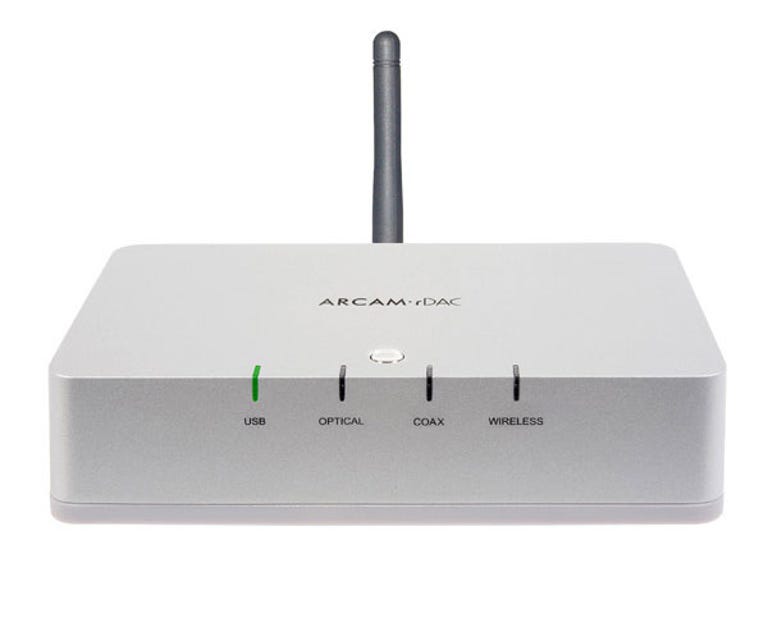 Why You Can Trust CNET
Why You Can Trust CNET Arcam rDAC wireless review: Arcam rDAC wireless
The Arcam rDAC wireless edition may not be worth the additional AU$400 or more on the standard edition, but it's still very talented in wired mode.
Editor's note: the Arcam rDac wireless edition is very similar to the Editor's Choice-winning Arcam rDac, but we cover the differences in the Wireless performance section below.
The Good
The Bad
The Bottom Line
Arcam has taken the DAC blue-print established by rival Cambridge's Audio DacMagic and expanded upon it with the release of two new models: the rDAC (AU$598) and the rDAC wireless (AU$775). If you buy a standard rDAC you have the option of buying an upgrade with a kit costing AU$198.
To use the wireless features of this edition you'll need to purchase one or two dongles: the rWave PC adapter (AU$198) and/or the rWand 30-pin iPod/iPhone (AU$198) adapter.
Design and features
As with the standard rDac, build quality is exemplary with a sturdy rubber base and a compact design, meaning it can fit into tighter spots than the DacMagic. If you're buying the upgrade kit version of the wireless edition, there is a rubber grommet on the back of the unit that peels off and lets you attach the antenna.
The rDAC features a higher specification than the DacMagic with the inclusion of a 24-bit/96kHz BurrBrown DAC that will also decode USB files at the same rate. This feature is welcomed as we criticised the Cambridge Audio product for its inability to process the free, high-quality music from the likes of Nine Inch Nails and Radiohead.
The rDAC features fewer inputs than the Cambridge though as it only has one optical, one coaxial and one USB. On the output side it does both kinds of (non-PC) digital and stereo RCA. Like the Cambridge it also jettisons a remote control. The device instead uses a push button on top to cycle through the four different inputs including wireless.
Wired performance
We used a mix of different devices to test the rDAC including the iPhone (using the digital output of the Onkyo ND-S1 dock), the Oppo BDP-83 Blu-ray player and the Marantz NA7004 network player. As we hooked the rDAC into the Sony STR-DA5400 receiver we also compared it to the onboard sound as well.
There are many benefits of buying an outboard DAC, especially if you have an older receiver or analog amplifier. Using the rDAC we were able to dig out much more of the sound imprinted in the disk or held between the zeroes and ones of the digital files. Music had more impact and vibrancy, with details that might have seemed throwaway before now suddenly given their rightful attention.
Vocals were simply more expansive than the Sony could muster and once-woolly basslines such as in Nick Cave's "Red Right Hand" were now given enough space to swing their meat cleavers around. This more expressive bass was also able to propel rock and dance music forward, getting the feet tapping (or running away, in St Nick's case).
Compared to the Marantz NA7004 and the DacMagic, the Arcam rDAC was able to carry a touch more exposition, and the ability to play 24-bit files meant that a new raft of music untouchable by the DacMagic was now playable.
Wireless performance
The wireless system works on the proprietary Kleer protocol that delivers lossless music on the 2.4GHz spectrum. "But hang on," we hear you say, "isn't that the same frequency used by laptops and such? Is there any interference?" Well, yes; and yes, there is.
Connecting the dongles is easy enough. The iPhone version is the quickest: simply connect the rWand to the 30-pin connector and the rDac will turn from red to green when it detects a signal. The rWave is a little more complex as it involves connecting the USB key-sized dongle and then choosing "Arcam sound card" from the sound properties on your computer. For Vista/Windows 7 users, this involves right clicking the speaker icon in your task bar, choosing "Playback Devices" and then choosing the device from a list. The only thing you need to remember before connecting either dongle is to change the rDac to the "Wireless" input, first using the top-mounted switch.
If you've already paired your devices the rDac will detect the dongles as soon as you connect them and will be playing your music or soundtracks within seconds. Audio quality of the wireless unit was seemingly indistinguishable from the wired version, and would be worth purchasing if it wasn't plagued with problems.
During our testing we tried two different wireless routers and found that the rWave interfered with the signal from both of them. Either the music would stop or the internet connection would freeze for seconds at a time. While this wasn't an issue with light web browsing — where the page is only refreshed after several pages of reading — it was definitely an issue when trying to move files around, such as in downloading.
In addition, the unit's lack of remote control functionality largely negates its usefulness. You still have to be within arm's reach of the rDac to change inputs anyway.
Lastly, dongles are small. They can easily get lost, and ponying up an extra AU$200 because your dog inhaled the rWand is something we wouldn't wear.
Conclusion
Judged purely on the wireless performance alone, the rDac is not a great streaming device: its interference issues and lack of a remote control make it too hard to use.
Nevertheless, the Arcam rDAC wireless is great at decoding wired devices, but there are cheaper ways to stream. One option is to buy a device like the Apple TV for AU$129, plug it into the standard rDac and then stream to it from your iPhone or iTunes.


